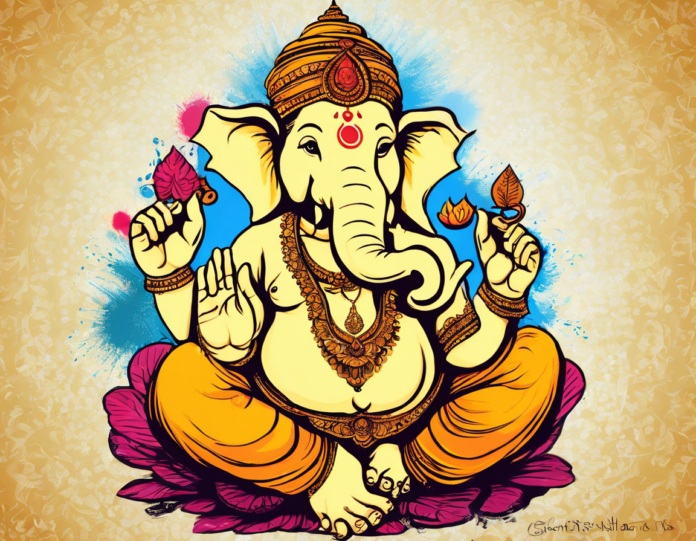Ganesh Chaturthi is a widely celebrated Hindu festival that reveres Lord Ganesha, the elephant-headed deity known as the remover of obstacles and the god of wisdom and prosperity. This auspicious occasion typically falls in the Hindu calendar month of Bhadrapada, which usually overlaps with August or September in the Gregorian calendar. The festival usually lasts for 10 days, with the biggest celebrations taking place in the Indian states of Maharashtra, Goa, Karnataka, Telangana, and Tamil Nadu.
The Origin Story of Ganesh Chaturthi
According to Hindu mythology, Ganesh Chaturthi marks the birthday of Lord Ganesha. One of the most popular legends surrounding this festival is the story of how Ganesha was created by Goddess Parvati from the dirt of her body while she was taking a bath. She then instructed Ganesha to guard the entrance to her sanctum while she bathed. When Lord Shiva, her husband, returned and found a stranger denying him access, he beheaded Ganesha in a fit of rage. Upon realizing his mistake, Lord Shiva promised to restore Ganesha's life and declared that he would be worshipped before all other gods. This is said to be the reason why Ganesha is worshipped first in Hindu rituals.
The Significance of Ganesh Chaturthi
Ganesh Chaturthi holds immense significance for devotees as it is believed that worshiping Lord Ganesha during this time can bring prosperity, wisdom, and success. The festival involves elaborate rituals, prayers, and offerings to Lord Ganesha. Traditional sweets such as modak (a dumpling made of rice or wheat flour filled with jaggery, coconut, and other ingredients) are prepared as offerings to the deity. The festival also includes the installation of Ganesha idols in homes and pandals (temporary structures or marquees), followed by daily prayers and cultural performances.
Celebrations and Rituals
The onset of Ganesh Chaturthi is marked by the installation of Ganesha idols in homes and public places, accompanied by elaborate rituals such as the Pranapratishtha (consecration) and the Shhodashopachara (16 forms of paying tribute). The traditional aarti (prayer) is performed multiple times a day, and devotees offer flowers, incense, and sweets to Lord Ganesha. The festival culminates with the Ganesh Visarjan, where the idols are immersed in bodies of water such as rivers, lakes, or the sea, symbolizing the return of Lord Ganesha to his abode while taking away the worries and obstacles of his devotees.
Environmental Concerns
In recent years, the immersion of Ganesha idols made of plaster of Paris into water bodies has raised environmental concerns due to the pollution caused by the non-biodegradable materials. To address this issue, eco-friendly Ganesha idols made of clay, natural dyes, and biodegradable materials have gained popularity. These idols dissolve quickly in water without harming the ecosystem, promoting an eco-sensitive approach to the festival.
Ganesh Chaturthi Around the World
While Ganesh Chaturthi is predominantly celebrated in India, the festival has gained global recognition in countries with a significant Hindu diaspora such as the United States, the United Kingdom, Canada, Australia, and Mauritius. Temples and cultural organizations in these countries organize public events, processions, and cultural programs to commemorate the occasion, fostering a sense of community among believers.
FAQs about Ganesh Chaturthi
1. What is the significance of the elephant head of Lord Ganesha?
Ganesha is often depicted with an elephant head due to the belief that he acquired it after Lord Shiva beheaded him and replaced it with the first available head, which happened to be that of an elephant.
2. Why is it important to immerse Ganesha idols in water during Ganesh Visarjan?
The immersion of Ganesha idols symbolizes the cycle of creation and dissolution in Hindu beliefs, signifying the impermanence of life and the return of all beings to the divine source.
3. How long does Ganesh Chaturthi last?
Ganesh Chaturthi typically lasts for 10 days, with the final day culminating in the Ganesh Visarjan ceremony.
4. Are there any specific prayers or mantras associated with Lord Ganesha?
Yes, there are various prayers and mantras dedicated to Lord Ganesha, with "Om Gam Ganapataye Namaha" being one of the most popular chants invoking his blessings.
5. What is the significance of modak as an offering to Lord Ganesha?
Modak is believed to be Lord Ganesha's favorite sweet, symbolizing his love for wisdom and knowledge. Offering modak during Ganesh Chaturthi is considered auspicious and is believed to earn the deity's favor.
In conclusion, Ganesh Chaturthi embodies the spirit of devotion, wisdom, and prosperity, inviting devotees to celebrate the auspicious presence of Lord Ganesha in their lives. Through rituals, prayers, cultural festivities, and eco-conscious practices, this festival continues to uphold its timeless traditions while adapting to contemporary environmental and social concerns.


Recent comments